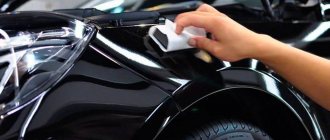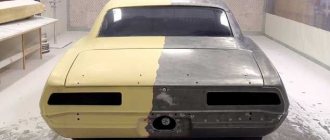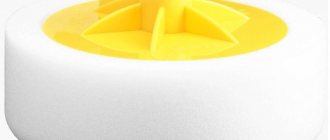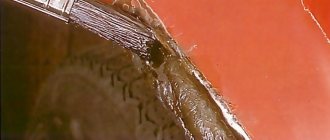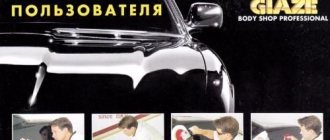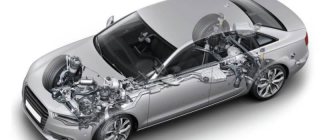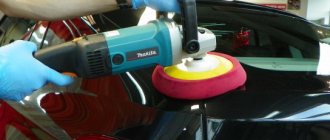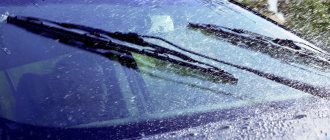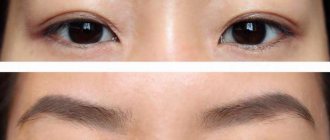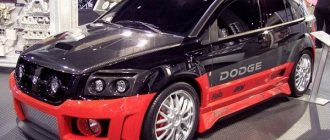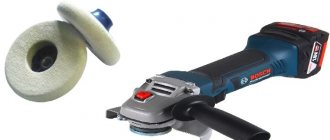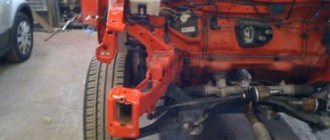Home » Buying a car » Checking the car body before purchasing
Friends, hello everyone! Vitaly Dmitriev is with you. In today's article, I will tell you why checking the body of a car before buying is so important. The most important and expensive element in a car is its body, so when inspecting a car we pay special attention to it. The chassis and motor can be repaired, no matter what happens to them; in extreme cases, the motor can be replaced with a contract one. And restoring crooked body geometry after a serious accident is quite expensive and almost impossible.
Awkward
Deformation of the body geometry leads to various problems:
- Unstable driving on the highway, the car constantly pulls to the side, and there may be vibration in the steering rack.
- The rubber of the wheel will wear out faster and unevenly, fuel consumption will increase, because there is no way to do wheel alignment, that is, set the correct wheel alignment angles.
- A failed part in a car suspension that is not replaced in time leads to the fact that many others will have to be replaced in the near future.
- Well, and most importantly, the geometry of the body, which once saved the lives of passengers as a result of an accident, will not be able to do this next time. If the metal structure is damaged in an accident, the car will collapse like a house of cards.
In general, we can talk a lot about non-deliveries of broken geometry, let’s better understand how to identify it and not buy a crooked car.
- Rule No. 1 (clean car, good lighting)
And so, the inspection must be carried out on a clean car in daylight, or in a well-lit place, so as not to miss possible body defects.
- Rule No. 2 (we use a paint thickness checker)
In order not to waste time looking at the car body and to eliminate errors in the inspection, I recommend that you always use a device that measures the thickness of the paintwork (thickness gauge).
You will spend several days, or even months, searching for a good car; the main thing is not to rush and buy the first car you come across. You will have to use the thickness gauge often, so if you have nowhere to borrow the device for free (for example, from friends or relatives), I do not recommend renting it for money. The total amount for all rental days may be higher than the cost of the thickness gauge itself.
Therefore, I advise it is better to purchase the device immediately, especially since it will be useful in the future. There is no need to buy an expensive, professional thickness gauge; it will be enough to purchase, for example, a GM200. I myself have been using it for several years, and I am quite satisfied with its capabilities. I talked about this device in this article.
- Rule No. 3 (we shoot with a thickness gauge in order)
We start checking the body from the roof of the car, because... it is extremely rarely damaged and is a reference sample for measuring paintwork. Of course, it can also be painted if the car has been turned over or completely covered in paint (freshened). Thanks to the thickness gauge, you will understand that the car has been repainted, because... its performance will vary greatly on different parts of the car.
How to determine whether a body is galvanized?
Before purchasing a car, the buyer definitely wants to know whether the manufacturer has galvanized the body? The reasons for this interest are quite understandable.
Galvanization increases the service life of the metal and reliably protects it from corrosion. But there are still undeniable advantages of galvanizing that you should pay attention to. In addition, there are methods for identifying a galvanized body.
pros
After galvanizing the metal, it receives the following properties:
- resistance to chemicals and moisture;
- persistent chemical protection from external influences.
But, on the other hand, there are also negative sides:
- From an environmental point of view, full galvanization is a minus. Scientists have concluded that such coatings are harmful and negatively affect human health and the state of the atmosphere;
- Galvanized body parts must not be cleaned or sanded, otherwise the treated area will immediately begin to rust.
It happens when the galvanization peels away from the paintwork. In this case, it is important to have the participation of craftsmen who will remove the necessary layer and professionally treat the affected surface.
In recent years, a myth has become widespread that zinc-coated metal does not rust. In fact, galvanizing inhibits the spread of corrosion, but the zinc layer does not guarantee reliable protection without additional treatment with an anti-corrosion substance.
Not everyone knows, but the zinc layer is only a couple of microns - such a thickness will not protect the body part from chemicals. Over time, the zinc protection of any car becomes thinner. This is facilitated by mechanical damage, for example, stones, the impacts of which accelerate the corrosion process.
When used, the metal is subject to vibration, which causes microcracks to appear; impacts cause dents, which provoke the onset of corrosion.
Galvanizing process
There are several zinc coating techniques.
Galvanic
This method is based on immersing metal parts in an electrolyte that contains a lot of zinc.
After this, an electric current is applied to the workpiece, which helps to attach a protective layer to the surface.
Full treatment means zinc coating of all metal parts of the body. If partial processing is performed, then only some parts are protected: the bottom, sills and other elements that are most susceptible to rust.
Cold galvanizing
This processing method is considered the most popular among some manufacturers in European and Asian countries.
The essence of the principle lies in two-stage metal processing:
- surfaces are coated with phosphate salts of iron, zinc or manganese;
- paint or primer is applied with the addition of fine zinc to the mixture.
Cold galvanizing is placed on a par with high-quality painting.
Professionals believe that this galvanizing method is a marketing technique. But it does not provide reliable protection against corrosion in the event of damage to the integrity of the coating.
Hot galvanized
This type of processing is performed on one or both sides. The methods for applying protective coating are as follows:
- the body element is immersed in a molten zinc solution;
- a protective layer of the composition is applied to the body sheet at the rental stage.
It is generally accepted that hot galvanizing provides a guaranteed effect and resistance to corrosion.
Is the body galvanized?
There are such determination methods.
Using special equipment.
In a single case, this method is not justified, since it is quite expensive. If the service center has special equipment at its disposal, then the price of the inspection will be such that it is more profitable to add money and buy a car whose body is precisely galvanized.
Studying technical documentation
Often, manufacturers report the presence of galvanization and its type. Moreover, the documents specify whether the body is fully galvanized or partially galvanized.
If you choose the second option, remember: on cheap machines, hot-dip galvanizing or galvanizing is not carried out due to the high cost of the work.
If it is stated that galvanization is applied to the body, then this may mean:
- zinc was applied only to some parts of the car body;
- the car body is completely covered with zinc-containing primer;
- Only some parts most susceptible to corrosion have been processed. Often such processing is performed using the “hot” or “galvanic” method.
- The machine is galvanized in compliance with the requirements only if the documents indicate complete processing.
Take the time to go online and make sure whether the car body is actually galvanized.
Conclusion
It is necessary to understand that the word “galvanization” for many sellers is just an advertising technique.
To ensure the presence of protection and its effectiveness, it is recommended to check the desired make and model of the car (taking into account the year of manufacture) via the Internet.
If possible, you need to do the appropriate checks at a service station.
Return to list of articles
Hind wings
After checking the roof, we move on to the rear fenders. We pay special attention to the places marked in the picture. If the thickness gauge showed that in these places there are traces of repair (the thickness is greater than the reference), this indicates to us that most likely the wing was cut. After serious accidents, when the stiffeners are damaged, it is not advisable to stretch the wing, straighten it and paint it. It’s easier and cheaper to cut off the damaged part, replace it with a new one and paint it. You can verify this by opening the hidden cavities in the luggage compartment, peeling back the trim and looking under it. There we will find non-factory sealant, most likely traces of corrosion and non-factory welding.
Carefully check the spherical parts of the body, namely the wing arches. They are most susceptible to external influences, and in case of repair they are often repaired using putty, because... On the back side of the wing there are stiffening ribs that prevent high-quality repairs.
Pay attention to the gas tank flap; it is usually used to select the color for painting the body parts of the car. If you find traces of removing the gas tank flap, then you can say with 99.9% certainty that the car has painted elements.
trunk lid
Next, we check the trunk lid, look at the fastening bolts, they should be undamaged and painted in the color of the body. Torn splines on the fastening bolts tell us that the cover has been dismantled. It can be removed in several cases: for painting or for ease of body repair, for example, it can be removed to straighten the rear fender from the inside.
There have been cases when, after an accident, body parts matching the color of the car are found during disassembly and they are installed in place of the damaged ones; the thickness gauge will not be able to detect replacements. Therefore, be sure to pay attention to the fasteners.
An important indicator in a car that can help identify signs of repair is the sealant. At the factory, it is applied automatically, using an original seam, along the perimeter of each body element. After repairing a body part, it will not be possible to apply the same seam. Therefore, on all body elements, be sure to pay attention to the sealant layer. Non-factory sealant is quite easily pressed with a fingernail and, if a thick layer is applied, when pressed, it is squeezed out from under the paint.
In the luggage compartment, be sure to fold back the rug, take out the spare tire and inspect the floor. It is also sealed and there should be no creases, cracks or signs of repair. Often they try to hide repairs in the luggage compartment with a layer of mastic or seal them with soundproofing material guerlain. Particularly suspicious may seem if the trunk floor is not completely sealed, but in parts. They may tell you that there was not enough material, but in fact, most likely, in this way they tried to hide the traces of repair.
Check for theft, arrest and restrictions of the traffic police, FSSP
All the necessary information about the arrest, theft and registration of a car is provided by the official website of the State Traffic Safety Inspectorate (GIBDD.rf). To obtain certain information about customs clearance or bank collateral, use the resources of the FSSP, FNP and Customs Service services (reestr-zalogov.ru, fssprus.ru).
A complete history with a guarantee and report generation can be ordered on specialized paid services that collect information from open databases.
The history of a car not only helps to avoid the unpleasant consequences of illegal purchase and sale, but gives a real market assessment, taking into account the technical condition, the ability to determine mileage and participation in an accident.
More articles about choosing cars at this link.
Checking a car by body number
About 94% of sellers try to hide facts from the car's history. Subsequently, the buyer faces the risk of purchasing a collateral, emergency, credit car, etc. And then - difficulties with moving in the purchased swallow, or, even worse, a trial followed by deprivation of the car and money. Therefore, it is always worth checking the car before buying, even if it does not have a VIN!
Doors
This example of removing the trunk lid also applies to the doors and hood. For example, repairing a jammed car threshold, for convenience, is often carried out by removing the door. Therefore, if you find traces of dismantling a body element that is in the factory paint, you need to try to establish the true reason for the dismantling.
So, let's move on to inspecting the doors. We measure them with a thickness gauge, and similarly look at the mounting bolts, hinges and sealant. On many models, control strokes are made from the factory on body fasteners in a color different from the body color. If an element with a control stroke is removed, this indicator will be damaged or not match the pattern, so we pay attention to this.
Tip 1: How to determine the year of production of a VAZ
Coupe
Coupe is a three-volume closed passenger body with two (less often four) doors and one or two rows of seats. The doors of the coupe are larger in size than those of the sedan, the second row of seats is reduced, and the roof in the rear has a sloping shape, which achieves the sporty appearance of the car. On some coupe models, the rear seats are not designed for frequent use and are therefore very small. In everyday life, such cars are called 2+2.
The coupe body is represented by cars from golf class (C) to executive class (F). A coupe that lacks a B-pillar is called a hardtop coupe . In such a car, when the windows are lowered, an open space is formed between the front and rear pillars. In Italy, the coupe goes by its own name Berlinetta .
Limousine
A limousine is initially a three-volume closed passenger body type, equipped with four doors and two or three rows of seats. A characteristic feature of the limousine is the presence of a glass partition, if necessary, separating the front row of seats (driver) from the rest of the cabin (passengers). A limousine can be an independent car model or an extended version of a sedan, SUV and hatchback. The Portuguese name for the limousine is Espada .
Hatchback
A hatchback is a two-volume closed passenger body, which is equipped with three or five doors and two rows of seats. A characteristic feature of the hatchback is the presence of an inclined rear door, made together with the rear window. The hatchback is the most popular body type in Europe. Cars with a hatchback body are presented in A, B, C, D, and less often E classes according to the European classification. The hatchback occupies an intermediate position between the sedan and station wagon bodies (more compact than a sedan and less bulky than a station wagon).
Thanks to its design, the hatchback can be converted into a cargo-passenger body. Why remove the shelf covering the luggage compartment and fold down the rear row of seats. The rear door of a hatchback may have a curved shape that makes it resemble a sedan. In the USA, such a body goes by its own name notchback .
Station wagon
The station wagon is a two-volume closed passenger body type, characterized by the presence of three or five doors, two rows of seats and a constant roof level. The characteristic features of a station wagon that distinguish it from a hatchback are its length, comparable to a sedan, and a greater slope of the rear door glass. At the same time, the positioning of a car as a station wagon is largely determined by the automaker.
When the rear row of seats is folded, the station wagon turns into a utility vehicle. In the UK, a station wagon is called Estate car , in France - Break , in Portugal - Carrinha , in Italy - Giadinetta , in Germany - Kombi (from Kombinationswagen), in Denmark - Stationcar . In the USA, a two-door cargo-passenger station wagon without rear side windows is called Sedan delivery. Some automakers give station wagons their own names for market promotion:
- Audi- Avant ;
- BMW – Touring ;
- Opel- Caravan ;
- Peugeot- SW ;
- Rover - Tourer ;
- Seat - Vario ;
- Skoda- Combi ;
- Volkswagen - Variant .
Cabriolet
Convertible (also known as Ragtop ) is a three-volume open passenger body type, equipped with a soft (fabric) and (or) hard folding roof, allowing driving in open or closed mode. A convertible with a removable roof is called a hardtop .
Marketers distinguish the roadster as a separate body type , which is a shortened two-seater body with a folding soft roof. But at its core, a roadster is a two-seater sports convertible. In Italy the roadster is called Barchetta .
In design, the passenger bodies of the targa (a two-seater or 2+2 car with a removable middle part of the roof) and brogues (a four-seater car with an opening part of the roof above the front row of seats) are similar to the convertible.
Minivan
The name minivan came to us from North America, the European name is People carrier (literally, carrier of people). A minivan is a single-volume closed passenger body type that has three or four rows of seats and can carry six or more passengers. The minivan is distinguished by an increased roof height. Modern minivans are built on golf-class (C), middle-class (D) and vans.
A minivan, designed on the basis of a van, has its own name - minibus ( Minibus ). The minibus is designed to carry up to 16 passengers in several rows of seats. Access for most passengers is through a sliding door on one side of the vehicle.
Van
A van is a single-volume closed cargo-passenger body type. The van has a partition that separates the cargo compartment from the passenger compartment. The van has no rear side windows, and the body height has also been increased. In North America, the van has its own name - Van . The van body type also includes a hatchback and a station wagon without rear side windows, designed for transporting small-sized cargo.
Pickup
A pickup truck is a three-volume cargo-passenger body type with an open platform for transporting goods. The cabin is separated from the cargo platform by a stationary partition. Modern pickup trucks are built on the basis of cars and SUVs. Pickup trucks are very popular in the USA. In Australia and New Zealand, pickup trucks have their own name ute ( Ute , from utility coupe, literally a general purpose coupe).
SUV
An SUV ( SUV , Sport Utility Vehicle , commonly known as a jeep ) is a two-volume closed passenger body type with five or six doors, one or two of which are rear, two or three rows of passenger seats. The SUV is distinguished by its large overall dimensions, the presence of all-wheel drive, reduction gears and increased ground clearance, allowing the vehicle to move on and off-road. Therefore, it is correct to call an SUV an all-terrain vehicle, but no one calls it that. At its core, an SUV is an all-terrain station wagon. SUVs and some pickup trucks and vans have a body-on-frame chassis.
Crossover (commonly called “ SUV ”) is a two-volume closed passenger body type. It is distinguished from an SUV by its monocoque body, compactness, and lower ground clearance. Crossovers are usually based on golf-class cars.
Power elements
Regardless of whether you find traces of repair on the doors or not, you definitely need to check the doorways (central pillars, sills and internal arches), they belong to the load-bearing structure of the body and are responsible for the geometry of the car. In the event of a side impact, the rack takes the entire impact; if it is discovered that the rack has been repaired, does not have factory seams, or has putty, it is better to immediately abandon such a car.
If you have any doubts about the door openings, remove the rubber seal and make sure there are factory spot welds underneath everywhere. If there is no welding in some places under the seal, then repairs have been made.
Advantages Autocode
A big plus of the online service is the ability to identify a car not only by VIN and license plate number, but also by frame number.
In addition, the Autocode website has the following advantages:
- All data is up-to-date, provided by official bodies of the executive and judicial systems, and is also entered into the traffic police database;
- Checking by frame or body number takes 5 minutes!
- The service has a mobile offer, which can be used at any time, anywhere;
- Technical support service is available.
Checking a car by body number can save you from many troubles, including collateral, credit and stolen cars. Problematic cars not only result in extra spending of money, but also the loss of the car itself. A few hundred spent before purchasing will dispel doubts about the desired purchase and confirm the correctness of your choice.
Front fenders
Next, by analogy with the rear wings, we inspect the front ones; here you need to pay attention to the inside of the wing next to the mounting bolts. Most cars are painted matte from the factory and should not be glossy. Compare these parts of the wings with each other. Also, if the wing is replaced with a non-original one, we will find that the stamping is not factory stamped.
Hood
Obvious signs of hood repair will be the same torn edges of the mounting bolts, smeared sealant that is not in factory form, and areas of severe corrosion. If you don't find sealant on the edge of the hood at all, it means it was replaced with a cheap Chinese hood that they didn't bother to apply sealant to at all.
In a car, the hood is most often repaired because it gets chipped from stones and sandblasting. There is nothing wrong with the fact that it was redecorated. The main thing for us is to determine whether the car was involved in a serious accident, as a result of which the geometry of the body was disrupted.
Why is this necessary?
A responsible car owner is always interested in maintaining the ideal appearance of his vehicle. This also applies to its technical condition. When a car gets into unpleasant situations such as accidents, traffic accidents, or runs into various obstacles, the appearance of the car deteriorates significantly. Even high-quality body work during restoration will not allow the paint layer to be preserved in the form it had before the accident. Needs repainting. Also, the paint can simply fade, wear off, and scratches and chips periodically appear on the body. All this forces the owner to paint over the defects. Sometimes only a small area of the body is processed. In other, more serious situations, it is necessary to carry out a full cycle of repainting the vehicle.
Engine compartment
Let's move on to inspecting the so-called shock absorber strut supports (glasses). It is important that factory sealant, spot welding and stamping are applied to them. The shock absorber strut support must be carefully connected by spot welding and factory sealant to the amplifier and mudguard of the engine compartment.
We inspect the side members very carefully, preferably with additional lighting; they also belong to the load-bearing structure of the body and are responsible for the geometry. If you notice traces of repair on the side members, not factory sealant, they may be covered with mastic to hide defects or, in the worst case, cracked, bent, or have traces of creases. In such cases, we immediately refuse such a machine.
VIN number
Don't forget to check the vehicle's VIN number, it is usually located under the hood, under the floor trim on a marked panel next to the driver's seat, and also on the driver's door pillar. You can check all the locations of the VIN number before inspecting a specific model on the Internet. In addition to the fact that the identification markings must not differ from those indicated in the PTS, there must also be no traces of non-factory painting, debris under the varnish, traces of welding, putty, poorly readable symbols, or any defects.
If during registration during inspection the inspector has doubts about the authenticity of the identification marking, the car will be sent for examination. If it is confirmed that the VIN number has been welded in or broken (the characters have been replaced), it will not be possible to register the car, and problems will also arise with law enforcement agencies.
How to find out a car's paint color by VIN code
In order to choose the correct paint number and order it from a dealer or auto repair shop, you must first identify the location of the VIN code. The unique paint code will contain information about the ratio of pigments that make up the enamel. For all of them, the code has a numerical value (for Ford it has an alphabetic value). After a thorough inspection of the car, you need to write out the signs from VIN 10-14 that will be required further.
There are several ways to find out the color by code:
- Information on the Internet. Now there are many specialized sites that allow you to accurately decrypt the VIN. Thanks to them, you can clarify the paint code and select it for your car.
- Dealer information. If the car was purchased new or used, but at a car dealership, the employees have the necessary information about the paint code. They will also help you find your VIN if you were unable to do it yourself.
- Technical certificate. From this document you can find out the name of the paint shade, but you will have to look at the exact code directly on the car.
- Auto repair shop. Masters of tinting and painting cars themselves find information about the type, composition and color of enamel before starting work.
Bumper
Bumpers are the last thing we are interested in, because... they are most often exposed to external influences. But if they assure you that not a single part in the car has been painted, you need to check them too. The thickness gauge will not help us with this, because... in modern cars they are made of plastic. So you have to look with your eyes. Pay attention to the end parts of the bumper, they are a good indicator. Usually, none of the painters in these places do it to perfection. If you find roughness, marks from sandpaper, paint spraying or smudges, then the bumper has definitely been painted.
How to learn to understand cars?
At first glance, it may seem that all cars are similar to each other. The only thing that differs is their size. Learning to understand cars is not as difficult as it might seem, the main thing is to have perseverance, a couple of car magazines and, of course, the Internet.
How to understand cars: basic recommendations
So, first you should know that each brand and car model, like a person, has its own characteristics, let’s say, a zest. First of all, passenger cars differ from each other in the type of body itself:
In addition, automobile manufacturers have produced a large number of their varieties.
This concludes the first part of the question, which answers how to understand machines well.
Second, no less important, is the ability to distinguish between the following body types:
- pickup;
- phaeton;
- hardtop sedan;
- brougham;
- limousine;
- cabover body;
- fastback;
- van.
Of course, at first, not only is it difficult not to get confused by these concepts, but it also seems impossible to remember their images. Then a diagram of the above body types will come to the rescue.
Having mastered not only the body type, but also the car brand, you should move on to studying the technical characteristics, which include: engine power, transmission, etc.
You shouldn’t strive to learn everything and anything about the automotive world in a couple of days. Everything comes gradually.
How to understand car brands?
The most popular manufacturers of luxury cars are: Renault, Audi, Fiat, Toyota, Lexus, etc.
What we need to understand
Our main task is to buy a smooth car! You shouldn’t immediately abandon a car in which you find 2-3 painted parts; you need to figure out the reason for their repair. It may have been a minor cosmetic repair due to some chips and minor scratches.
If thickenings are found on any body element that are larger than the average thickness of the car’s paintwork, special attention should be paid to it. Be sure to look at the hidden cavities, this is the only way to understand the scope of the repair. Because it is extremely rare for anyone to remove traces of repairs from the inside.
We refuse the car, no matter how much it attracts us, if we find traces of repairs on the central pillars, inner arches, side members and on the floor under the spare wheel. Because repairs to these elements indicate serious damage to the body geometry.
I advise you not to look at cars that are covered with film; it is not known what is underneath it; perhaps they tried to hide body defects with the help of film. It is much cheaper to cover a car with film, especially Chinese, than to repaint the car. Take your time when choosing a car, you will definitely find the right car.
Have a nice day and happy car shopping. Come again!
Share this post
- Related Posts
- Certificate of acceptance and transfer of the vehicle to the purchase and sale agreement
- Which car model is better to choose?
- We check the PTS for authenticity
- Electronic PTS when purchasing a new car
- Profitable purchase of seized cars at auction
- What to ask a car seller over the phone
Discussion: there is 1 comment
- Alice:
10/19/2017 at 17:54This is probably the easiest to disguise
Answer
Decoding the VIN code
The VIN code is a specific cipher. It consists of three groups of indicators:
- International Manufacturer Index (WMI). The first digit is the locality code of the manufacturing country, followed by 3 characters indicating the name of the manufacturer and production department.
- Narrative (VDS). Five numbers correspond to the description of the car - model, body type, transmission, engine, specification.
- Distinguishing part (VIS). The remaining characters (10-17) determine the year of manufacture, vehicle serial number, and check digits.
The selection of paint based on the VIN code of the car is carried out according to the distinguishing part of the information. The type of paint is indicated by the sign number 10 (Y - plain, Z - metallic), then three characters (11-13) correspond to a unique paint code (for example 547). The last 4 digits of the control information encrypt the car's trim options, its interior, and the features of this configuration.
Thus, you can find all the information about paint when buying, selling, or repairing a car, and also find out whether the vehicle has been repainted or whether it is a “constructor”. An unknown VIN number can only be found on a vehicle over 30 years old - such marking was not practiced before.
